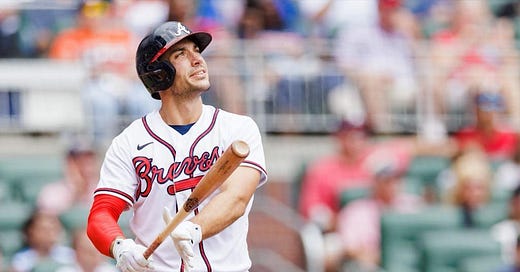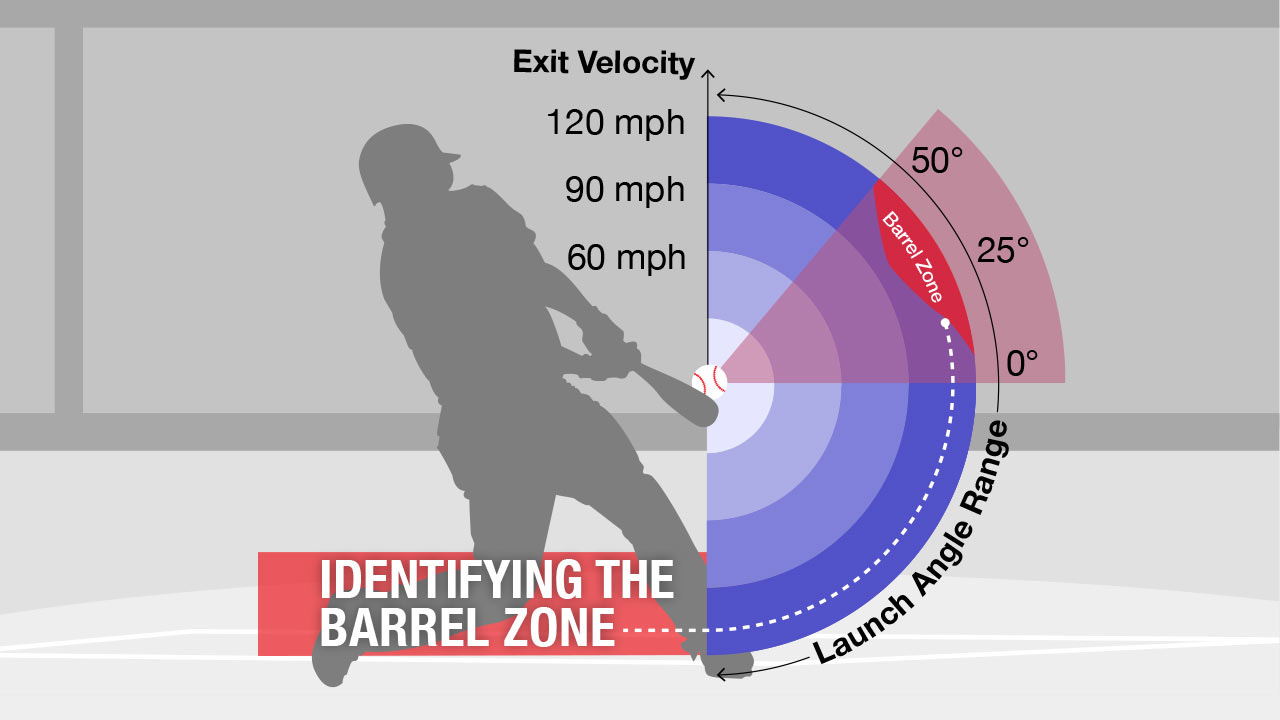The Braves love barrels. In 2024, barrels haven't loved them back.
Atlanta's offensive underperformance is partially explicable by its awful luck with hard-hit fly balls.
There have been plenty of theories over the last month to explain the Braves’ offensive doldrums, ranging from certainly true (‘when Chadwick Tromp has started a quarter of your games and Zack Short was your third baseman for a two-week stretch, you’re not going to be particularly good’) to quackish (‘Eric Young Sr. and Ron Washington were the offensive engine of this team, not the hitters themselves or their extremely well-regarded coach’).
Let’s get this out of the way: the Braves offense has been worse in 2024 than 2023; it’s not all bad luck. The 2023 Braves offense posted a .363 xwOBA; as of the end of the Braves’ series against Oakland on June 2, the 2024 Braves offense had posted a .332 xwOBA. They’ve struck out more, they’ve walked less, and they’ve hit fewer homers.
But the 2023 offense was always going to be a crazy outlier. Ranking offenses by xwOBA over the last 3 seasons, the difference between Atlanta and the 2nd-place 2024 Yankees (.015) is equal to the difference between the 5th-place 2023 Rangers and the 32nd-place 2022 Mets. Would you be surprised if I told you that based on walks, strikeouts, and batted-ball quality, the 2024 Braves offense is better than the 2022 offense across the board? Remember that 2022 team, with Austin Riley’s torrid July and Michael Harris II’s debut season and William Contreras’ breakout? Well the 2024 team strikes out less, it walks more, and its xwOBA on balls in play is just a hair worse (.406 to .398).
So looking at the things the Braves offense can control, it’s been good, if not the generational force it was last year. As of June 2, the Braves ranked 7th in xwOBA. It was also ranked 7th in wOBA, since 28 of 30 teams are underperforming their xwOBAs at least a bit at this point. (Perhaps this will change as the cold-weather part of the data becomes a smaller and smaller piece of the total sample.)
I want to talk about a weird phenomenon that has afflicted the Braves in particular, though: their rotten luck with barreled balls.
Why do barrels matter?
You know how Chip Caray would always say, “Put the ball in play and good things can happen,” and you’d think to yourself, “Well, sure, but bad things can happen, and as a general rule, bad things do happen, because there’s no hitter who’s ever run a BABIP over .500”?
No? Just me?
Well, barrels are - by definition - balls in play that likely will result in good things. They’re balls in play hit at an optimal combination of velocity and launch angle. The more optimal the launch angle, the less important the velocity - and vice versa. So you get a cone like this:
It’s possible to get a non-barreled homer (the technical term for these is ‘cheapies’), and it’s possible to get a barreled out. But barrels are unambiguously good. They’re the best thing a hitter can do at the plate.
Barrel the ball over and over again, and good things will happen.
Atlanta’s changing barrel fortunes
Last season, Atlanta led the league in barrel rate, with 11.9 percent of batted balls qualifying for this elite category. Only one other team - Minnesota - even had a double-digit rate. This season, the Braves have ranked third in barrel rate (first in the NL) with a 9.5 percent barrel rate. So there’s been a real drop, but not a crazy one. The Braves have been really good at barreling balls, even if they’re not the literal best at it this season.
What’s weird is what happens when the Braves do barrel a ball. The Braves have an xwOBA of 1.276 on barreled balls and a wOBA of .995. That’s the largest xwOBA-wOBA differential in the league by a significant margin. And the Braves’ .995 wOBA on barreled balls is the worst in the league. Another way of saying this is that despite the Braves hitting a lot of barrels, they’re getting the least out of each barrel of every team in the league, and it’s predominantly because they’ve had awful luck.
Let me show you an example of brutal luck.
Adam Duvall cranked this fly ball. 109.4 mph off the bat, 35 degree launch angle. In the Statcast era, 102 balls have been hit with EVs between 108 mph and 110 mph and a 35 degree launch angle. 92 have been hits. 89 have been home runs.
Duvall’s fly ball eases onto the warning track.
Maybe this is backspin. Maybe this is a deadened ball. But last year, this is what that exact same combination of exit velocity and launch angle looked like.
The outlook
The good news is that there’s no reason to think that Braves hitters are chronic xwOBA underperformers on fly balls. Last season, Atlanta had a 1.318 wOBA and 1.344 xwOBA on fly balls; technically underperformance, yes, but marginally so.
Finally, I’ll add that if you feel like the Braves have hit more 50-50 barrels than last year (as opposed to no doubters), that’s definitely true. The Braves’ 1.276 xwOBA on barrels ranks 19th leaguewide this year; it was 1st last year. Note that this isn’t exactly the most relevant category, though: we’re talking about a statistic where Oakland ranks 3rd, the Angels rank 4th, and the Dodgers ran 23rd.
So yeah, it would be great if the Braves just go back to barreling the ball at a historic rate the rest of the year. But my point here is that it’s important to understand exactly what you’re seeing. Some people are spinning the Braves’ May as the natural result of a team regressing from a historic height. To hear these people tell it, what you saw for the last month is an accurate depiction of what to expect moving forward. But that’s just not true. Sure, the Braves will not match their 2023 highs offensively - losing the reigning MVP will tend to put a dent in those efforts anyway. But this is still a really good offense. Perhaps the batted-ball fortune in Tuesday night’s game is a sign of happier days to come.
This newsletter is free. Please consider donating to Equal Justice Initiate (eji.org) if you enjoyed it.







Tough news for anyone who was expecting that 2023 ATL offense to be replicated!
Nice piece.